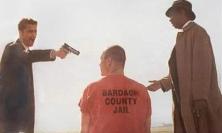Throughout Lent, we have been using iconic films to examine the way in which the Seven Deadly Sins filter into our daily experience. Concluding our series, Philip Endean SJ looks at the dynamic of wrath in the 1996 film Shine. But how much have we achieved by becoming aware of the presence of these sins in our lives? In Holy Week, we are reminded of the limitations of our own penitential efforts and encouraged to open ourselves to the possibility of the only gift through which we can be redeemed.
Shine, an Oscar-winning Australian film from 1996 by Scott Hicks, is based (loosely) on a true story.[1] Its central character is a prodigious concert pianist, David Helfgott, whose career is cut short by a severe nervous breakdown. Born in Australia in 1947, David is brought up in wretched circumstances. His father, Peter, himself damaged and traumatised, is abusive, instilling in his child both an unhealthy drive for success and a deep insecurity about the world beyond the family. David’s mother, Rachel, has long since capitulated to her husband’s neurosis and provides no balance or support. David’s talents nevertheless attract a good teacher at home (about whom Peter is grudging and ambivalent), and scholarships firstly to the USA (which Peter vetoes) and subsequently to Britain (which an older David, in the teeth of his father’s opposition, takes).
In London David studies with one Cecil Parkes—played in delightfully hammy fashion by John Gielgud—and wins a major prize at the Royal College of Music with his rendition of Rachmaninov’s Third Piano Concerto. This dramatic piece was one that Peter had pushed him to play as a child, at a time when David’s teachers were more concerned with scales and Mozart. Even now, the emotional weight of the successful performance is too much for David to bear, and his madness definitively sets in. He is hospitalised, submitted to electric shock treatment and sent back to Australia in bits. In and out of asylums, and permanently damaged mentally, he makes some sort of living as a café pianist, for he can still reduce the clientele to silence with his rendition of an equally virtuoso Rachmaninov piece, albeit far slighter emotionally: ‘The Flight of the Bumble Bee’. Eventually David meets Gillian, a woman strong and good enough to contain his eccentricities. After an implausibly eccentric and brief courtship he marries her, resumes a concert career of sorts, and lives happily, if often manically, ever after.
The Vice of Wrath
Thinking Faith is ending its Lenten series with a piece on Shine[2] because the strongest parts of the movie can be viewed as a study in the capital vice, or deadly sin, of wrath. Perhaps a trained psychologist could show how wrath contributes to David’s clinical breakdown and mania. But more immediately and obviously, the wrath is concentrated primarily in Peter.
At the outset, we need to make a distinction. Christian tradition, perhaps mirroring civilised society as a whole, is ambivalent about anger. Angry people are disruptive; by definition they want things to be different, and are prepared to be anti-social and disagreeable until they succeed. To the extent that Christianity reinforces social norms, it finds various ways of marginalising, even condemning anger. But to the extent that Christianity is an agency of change and conversion, both social and individual, anger is an important source of positive energy. The perception of unmet needs provokes responses that can be termed angry: if the perceptions are correct, then the anger is righteous, a hunger and thirst for justice that is to be sustained, not repressed. Anger is problematic only if the perception of unmet need is somehow wrong, or the resulting action out of keeping. When such disproportion is habitual, it becomes a vice—for convenience we can use the word ‘wrath’ to denote vicious anger. It is wrath, displaced and hence vicious anger, that Shine explores so powerfully.
‘A Very Lucky Boy’
The first hour or so of Shine presents the experience of David as a vulnerable child and adolescent. As adult observers, we can tell that wrath is driving Peter; for David himself, powerless against his father’s authority, the experience is unpredictable, terrifying, without rationale. A symbolic shot of barbed wire hints that Peter is a concentration camp survivor; more personally, Peter tells David about how he himself had been deprived of music and how his own father had smashed a violin for which Peter as a child had saved up. The vehemence with which Peter forces David to repeat, ‘I am a very lucky boy’, ironically reinforces a generational continuity of terror.
David’s pianism is at once his salvation and his downfall. Through it he can succeed, and thus gratify Peter; through it, indeed, he manages temporarily to leave Australia and his family. But his artistic and interpretative gifts also sharpen his sensitivity to the destructive emotional messages he receives. Our first view of David the child comes at a music competition, where he plays the Chopin A flat Polonaise so powerfully that not only are the audience impressed but the scruffy upright piano, in bad repair as it is, begins to roll on its wheels away from him. As the piano threatens to fall off the stage, David struggles to hold on, all the time playing the notes; and Peter says proudly, ‘he’s my son’. The episode foreshadows the later breakdown. Parkes’s exclamation as David practises the Rachmaninov points up the connection; ‘Don’t you just love those big fat chords. You have to tame the piano, David, or it'll get away from you. It's a monster. Tame it, or it'll swallow you whole.’
Rescue or Repentance
What might this film tell us about wrath in particular, and the vices in general, as we move through Holy Week? The religious background of the film is a secularised and embittered Judaism; cynically, David is put through a Bar Mitzvah by his father in the hope of raising money, but none of the characters seems to be religiously engaged. Nevertheless Shine, perhaps only unconsciously, resembles the gospel passion narratives in drawing on motifs from Israel’s bible: the innocent sufferer, subject to overpowering evil while yet receiving and enacting a frail promise of hope. David’s story can thus sharpen our sense of the gospel message.
David is far closer to the Psalmist crying out for help than to the Aristotelian citizen cultivating his virtue and weeding out his vice. David’s problems are a matter of predicament, not fault. Evil besets David, to be sure, but not an evil that anyone is free to change or repudiate. Neither David nor his father is in any obvious, personal sense sinfully responsible for the story’s catastrophes. When relief comes, it is not a matter of agents repenting and doing penance, but of outsiders—teachers and supporters who do their best in David’s childhood, and ultimately Gillian, the woman he marries—breaking into David’s incestuous plight with liberating love, at least incipiently.
At the outset of this series Nicholas Austin outlined some of the rich history behind the classical seven forms of bad behaviour we have been considering. It is generally thought that the catalogue originates in the literature of desert monasticism, specifically in Evagrius of Pontus, who speaks of ‘eight thoughts’, eight negative ‘categories in which every sort of thought is included’.[3] For Evagrius, our freedom over these realities is constrained: ‘Whether or not all these thoughts trouble the soul is not within our power, but it is for us to decide if they are to linger within us or not and whether or not they stir up the passions.’ The reality of evil may involve our freedom, but it also constrains it.
The mood as Lent begins is ascetical; in our fervour and enthusiasm, we may well try to have a go at rooting out a vice or two. No harm in that. But we are dealing with principalities and powers beyond our conscious freedom; on their own our efforts at self-betterment are futile. We depend on a salvation that comes from outside, on a ‘mystical’ gift that we can only receive.
Abuse of the kind that David inherits requires us to stress this difference. If the spirit is already crushed, calls to root out vice and work harder at the moral life will only make matters worse. People in David’s plight need relief, not exhortations. The traditional faults catalogued by Evagrius and his successors are called both deadly sins and capital vices. In some situations at least, the difference here is not trivial. When we speak of a deadly sin, we are implying that it is the perpetrator’s fault. A vice, by contrast, is a habit, something that may be instilled in us by our conditioning; the bad actions which emerge from it are not necessarily or wholly our responsibility. Vicious actions, therefore, however damaging, are not always to be identified with sins. And salvation from vice involves grace first, and repentance or asceticism only later, if indeed at all.
‘What Loads My Hands Down?’
Nevertheless, though the difference between vice and sin is important, we cannot distinguish them fully. Questions about how we are and are not free in our behaviour haunt Christianity. Orthodoxy here depends on our not tidying things up too easily or quickly. In the tradition, Ignatius Loyola may come closest to the truth because his chosen genre, that of prayer-exercises, enables him to avoid the conceptual conundrums. In the First Week of Spiritual Exercises, he gives us one exercise about sin as conditioning, and another about the sin we actively commit. Neither can be excluded; both repentance and liberation are needed. But the balance and the connections are left to be pieced together, never completely, on the basis of the ever new ways in which the creator deals with the creature.
‘What loads my hands down?’ The human predicament evoked in Philip Larkin’s evocative poem ‘Going’ permanently bedevils us. For all the differences between the articles in this series, it has been important that the theoretical catalogue of capital vices or deadly sins, an attempt to impose some sort of order on our negative experience, has been balanced by a focus on films. In this medium, agency and responsibility become fluid, hard to apportion; reality appears in a variety of perspectives that may be conflicting.[4]
In Shine, this fluidity is expressed most fully through the music. Rachmaninov’s sinuous, tumultuous Third Piano Concerto becomes a driving force in the story, rather as the better known and more romantically tuneful Second Concerto impels Brief Encounter. The wild movements of the piano become for David the theatre at once of destruction and rebirth. We may catalogue our virtues and vices, examine our consciences, and take our moral inventories. But this will take us only so far. The reality of what is happening is more elusive. Sages and saints alike remind us that, in the face of unfathomable darkness, we rely ultimately on gift, grace and improvisation.
Light Inbreaking
In his teens, David is befriended by an elderly woman novelist, Katharine Pritchard, a co-founder of the Australian Communist Party (a detail which Googie Withers’s elegant performance makes hard to believe), and he visits her house to practise on her piano. One day, David asks Katharine about her father. She reminisces about how she once spilled ink and scrawled over important papers on her father’s desk, and how he, instead of acting on his initial anger, ‘ran at me and picked me up and cuddled me breathless’. David says nothing, but is obviously moved. Katharine’s story of an emotionally warm father is resourcing him deeply. In the next scene he makes his break for London in the teeth of Peter’s physical violence. But on the psychological surface, the idea that a father can be different from Peter only intensifies David’s confusion. We are not far here from the teaching of John of the Cross: when God’s light begins to work on a darkened soul, the initial real benefits are overwhelmed by an excruciating pain of contrast.
Shine is about recovery as well as about wrath. The wild monstrousness that David cannot tame is more than a threat, and Christian reflection on sin always goes awry unless hope is somehow evoked, preferably as mysteriously as possible. One strand of biblical reflection on Christ’s cross brings out how it represents both our plight and our liberation. Salvation comes ‘in the likeness of sinful flesh’. Just as God restored the unfaithful Israelites in the desert by having Moses lift up one of the poisonous serpents plaguing them, so the Son of Man is lifted up on a tree—an emblem of primaeval curse—to draw all to Himself. The tree of life is also a tree of victory.
Active pursuit of the moral life is of course important and we must do what we can. It is good for most of us that we have Lent to ginger us up. But Christians think about the negative and vicious aspects of life not in the end because of what we can do to remove them, and still less as an exercise in morbid self-analysis. Rather, our concern is to open ourselves more fully, amid the darkness, to the light’s shining. Frail it may be, and as yet barely perceptible, mixed up as it is in our mess. But in the end the darkness will not master it. [5]
Philip Endean SJ is a tutor in theology at Campion Hall, University of Oxford.
[1] The factual accuracy of Shine has been disputed. Even the film itself, after the credits have rolled, shows a brief disclaimer about details. Peter Helfgott came to Australia from Poland as early as 1935, and David’s sister, Margaret, has written a book angrily challenging Shine’s portrayal of her family: Out of Tune: David Helfgott and the Myth of Shine (New York: Warner, 1998). For a trenchant negative review of the film, click here.
[2] There are numerous clips of Shine on video websites. Particularly helpful are the three to be found on http://aso.gov.au/titles/features/shine/.
[3] For Evagrius’s description of the ‘eight thoughts’, see the Praktikos, nn. 6-13, most conveniently in the version on the website of Fr Luke Dysinger OSB. There is a useful English edition of most of Evagrius’s writings by Robert E. Sinkewicz (Oxford: Oxford UP, 2003).
[4] The brief discussion of vice and sin here owes much to the first chapter of James F. Keenan SJ, Goodness and Rightness in Thomas Aquinas’s Summa Theologiae(Washington, DC: Georgetown UP, 1992), currently available online here.
[5] The last paragraphs allude to John of the Cross, Dark Night of the Soul, 2.5.5 in the standard Allison Peers translation, and to the following biblical verses: Romans 8:3; Numbers 21: 4-9; John 3: 13-15; Galatians 3:13; John 12:32; John 1:5.






